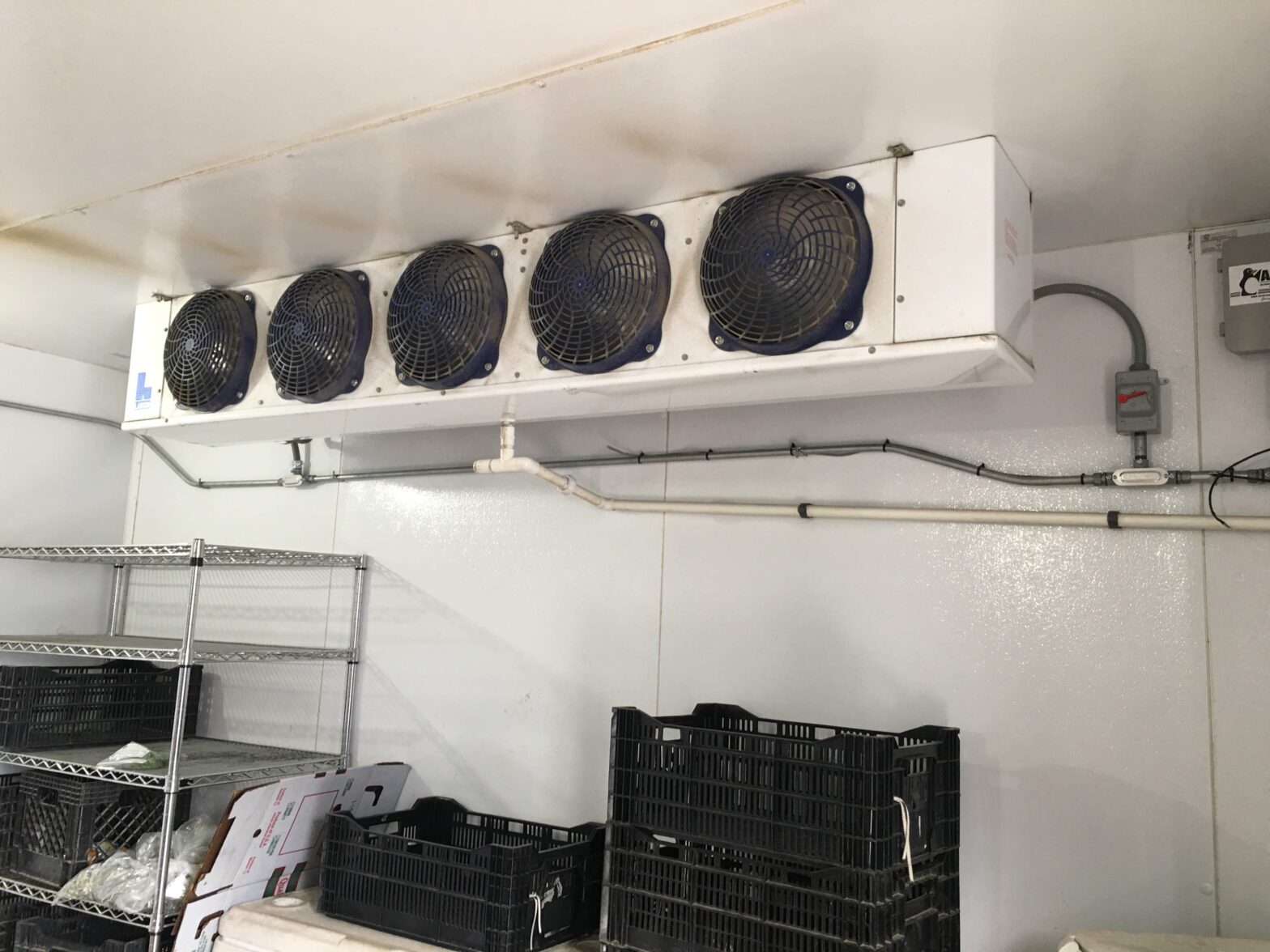Whether your winter storage rooms are getting bare or you are making the transition from sweet corn to potatoes, what better time to do a good cleaning and even sanitizing than now?
Download this Guide & Checklist as a PDF
Housekeeping
Start by emptying the room and removing all visible debris with sweeping or vacuuming. Next clean with an appropriate cleaner or detergent soap and rinse if needed according to the product’s label. A final step of sanitizing surfaces according to the sanitizer’s label may be prudent and could improve storage quality and food safety (http://go.uvm.edu/clean-sanitize-disinfect). If you’ve used water to rinse, wash or sanitize, be sure to allow time and air flow (and maybe even some heat) for complete drying before packing the cooler again.
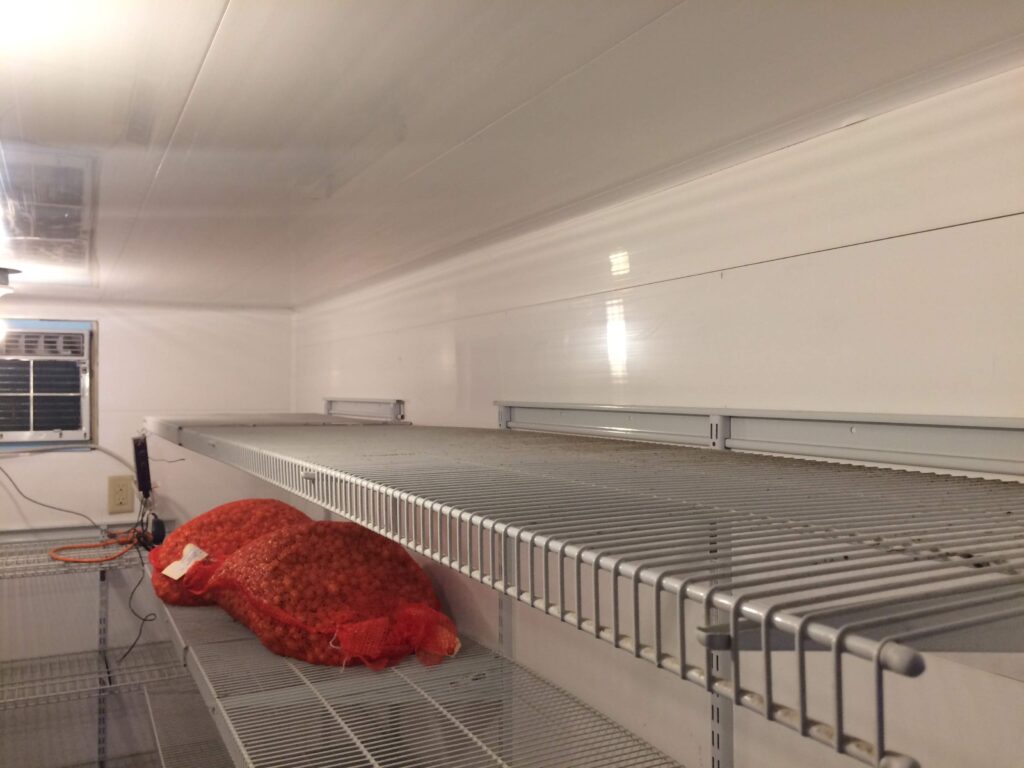
This is also a good time to check over the construction and make some simple repairs that are not so simple when tons of produce are in the way. Some examples of maintenance items might include; finally connecting that evaporator drain so it doesn’t drip condensate on the bin below, replacing damaged paneling and insulation to prevent rodent visitation and heat gain, replacing exposed light bulbs with shatter proof fixtures, energy efficient upgrades through your local utility (Efficiency Vermont), or sealing up corners and other areas. More details are provided below and a quick reference checklist is provided on the reverse.
Finish Surfaces
How clean can you get the inside of your storage room? If you currently have untreated plywood or chipboard, think about upgrading to a smooth, cleanable surface. These finish materials make the space a whole lot easier to keep clean, can help prevent plant pathogens in storage, can improve food safety and make the space more pleasant to work in. Sometimes dairyboard (known as fiber reinforced plastic, or “FRP) can come loose from the wall if the incorrect adhesive is used or the installation is otherwise lacking.
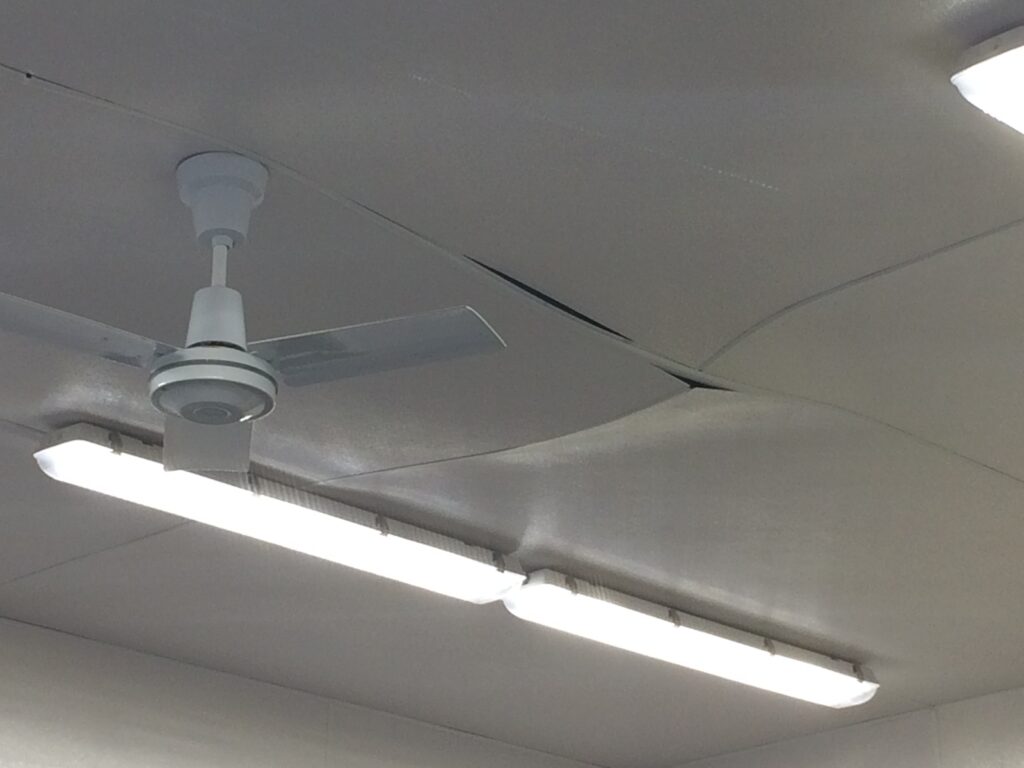
Envelope Check
You can improve energy efficiency, increase storage quality and reduce rodent damage by maintaining a strong and tight envelope around your storage room. While you’re cleaning, check all the walls, corners, and door to be sure they are in good repair and are functioning well (http://go.uvm.edu/coolerwalls). Replace worn rubber seals, make door closer and latching adjustments to ensure a tight seal, close the whole room up while standing inside with the lights off and look for daylight around the door or other areas. Seal those spots up. Look for signs of condensation inside and outside and seal, insulation, or ventilate to address it. Any gaps in your sheathing or other holes in walls, corners, etc? Seal them up. Obvious signs of rodent intrusion should get extra attention and rodent control measures should be taken.
Equipment Check
Now is a good time to make sure your refrigeration and other temperature control equipment is working as planned.
Connections
Check any visible electrical wiring and refrigerant lines. Any significant wear or obvious damage that should be repaired now? Are refrigerant lines still well-insulated?
Inside
Check the evaporator (the place the cold air comes from). Can you see through the fins clearly in every channel (you may need to shine a light from the opposite side)? Is the drain pan clean and free of debris? Is the drain connected to piping or hose and directed to the floor, a bucket or an outside drain? Is the drain clear, clean and functioning properly? Have you noticed any increased noise or rattling that could indicate something may soon need replacement? Are you seeing condensation in certain parts of the cooler? This could indicate a need for improved circulation of air or envelope repair.
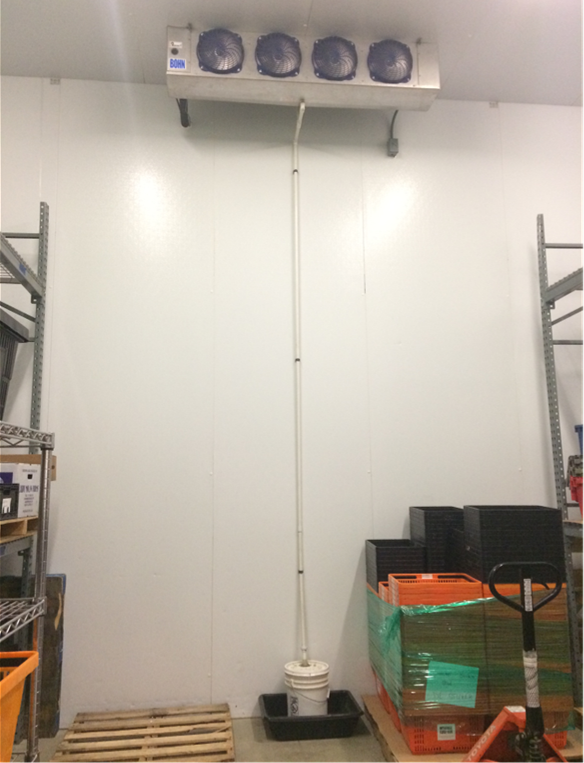
Outside
Are the compressor (generally a black cylindrical part) and condenser (radiator and fan) clean and clear of debris? Grass, leaves, dirt, etc. should be removed from the equipment. Condenser (radiator) fins should be cleaned with a vacuum and even pressure washed to provide for effective heat removal and improved energy efficiency. Is there good air movement possible around the condenser? Is this the year to put a roof on the compressor and condenser?
CoolBots™
Check the pitch of the AC unit. It should be pitched slightly to the outside and there should be a drain hole at a low point to allow water to drain out of the bottom. Are both heat exchangers clean and clear of debris and dust? Is there a good seal around the AC unit to prevent air infiltration? Does your AC unit have a “vent”? Check to be sure it is set in whatever position you want. Venting (or fresh air) will bring in some outside air which is good for higher ethylene producers or crops seeking lower RH storage. Otherwise, the vent should be closed. Also check your CoolBot wiring and especially your fin sensor to be sure they are securely fastened and in position.
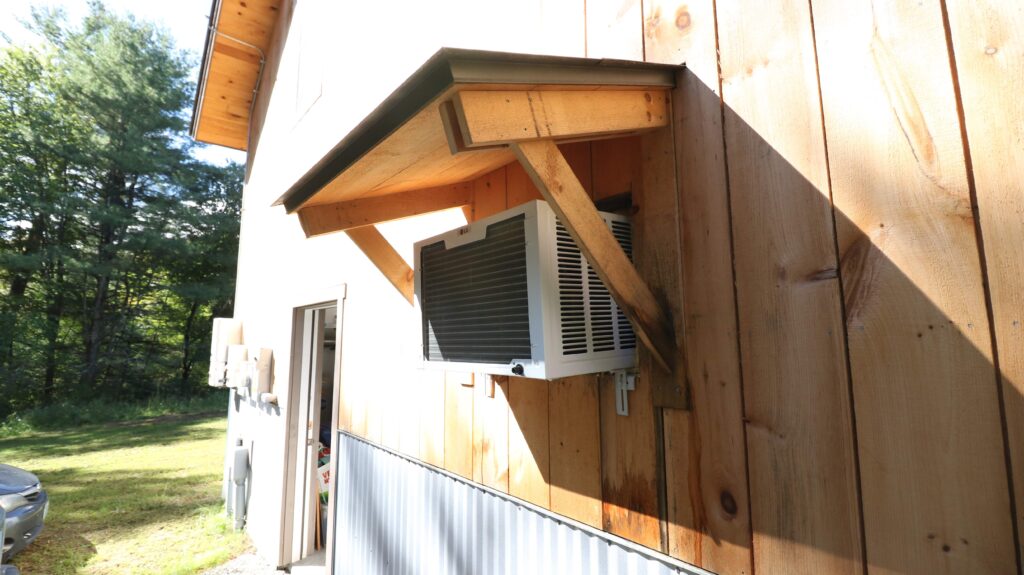
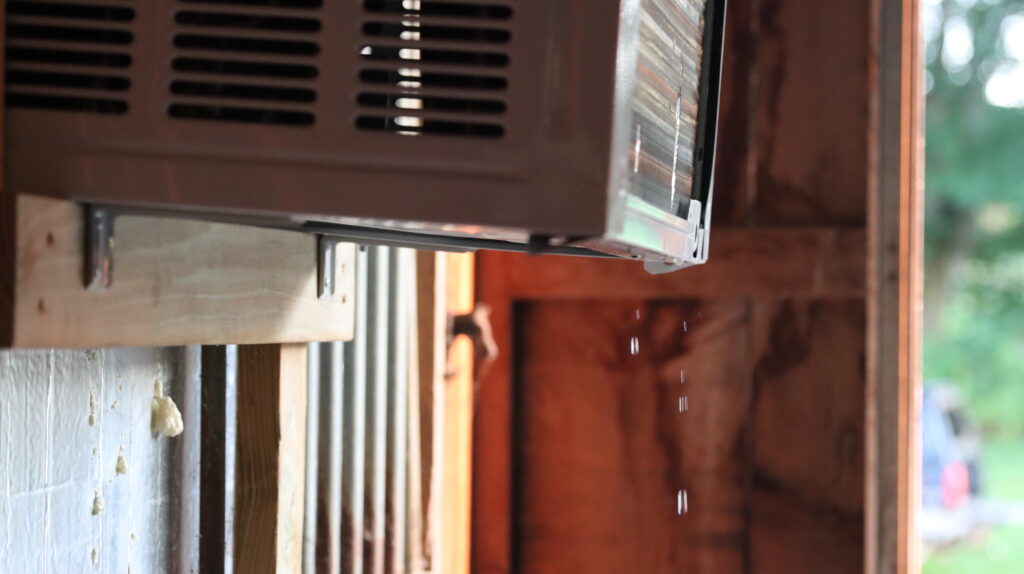
Opperation
Power up the system and adjust your thermostat to force a call for cooling. Inside – Are all evaporator fans coming on as they should? Is the unit producing cold air? Outside – Is the compressor coming on when there is a call for cooling? Is the refrigerant hot where it should be (between the compressor and the condenser or outside heat exchanger) and cold where it should be (going back inside to the evaporator)?
CoolBots™
Does the AC unit power up? The fan should be blowing air. The compressor should come on within about 30 seconds. The CoolBot control should power up and indicate your set-point and current temperature. Does the AC unit produce cold air? Maintenance and troubleshooting guides and videos are available from StoreItCold’s website, links at http://go.uvm.edu/coolbots.
Controls/Thermostats
Is your thermostat as tired as you are? Does it allow you precise control of temperature? Is now the time to upgrade or replace it?
Lighting
Do you have functioning lights? Is now a good time to add them in? We have a guide for estimating the amount of light needed for specific tasks. How about an automatic occupancy switch so they turn on or off automatically when your hands are full of that awesome produce? Have you considered shatter-proof lighting fixtures? Or energy efficiency upgrades (http://go.uvm.edu/effvtag)?
Plan for a Full Room
Think about last year’s storage season and what you had a hard time reaching when you needed it. Can you change your loading this year to make access easier? Also remember that you likely have a variety of conditions in your storage room with the coldest, driest, highest airflow zone being close to the evaporator and the warmest, most humid, still zone being at the end furthest from the evaporator. Does your planned loading take that into account? Should crops be relocated to accommodate optimal storage? Any other lessons learned from last year that you can take action on now? Should you consider building additional storage space now to accommodate any expanding production? Our crop storage planning tool may be helpful to estimate storage and zone needs (http://go.uvm.edu/cropplanner).
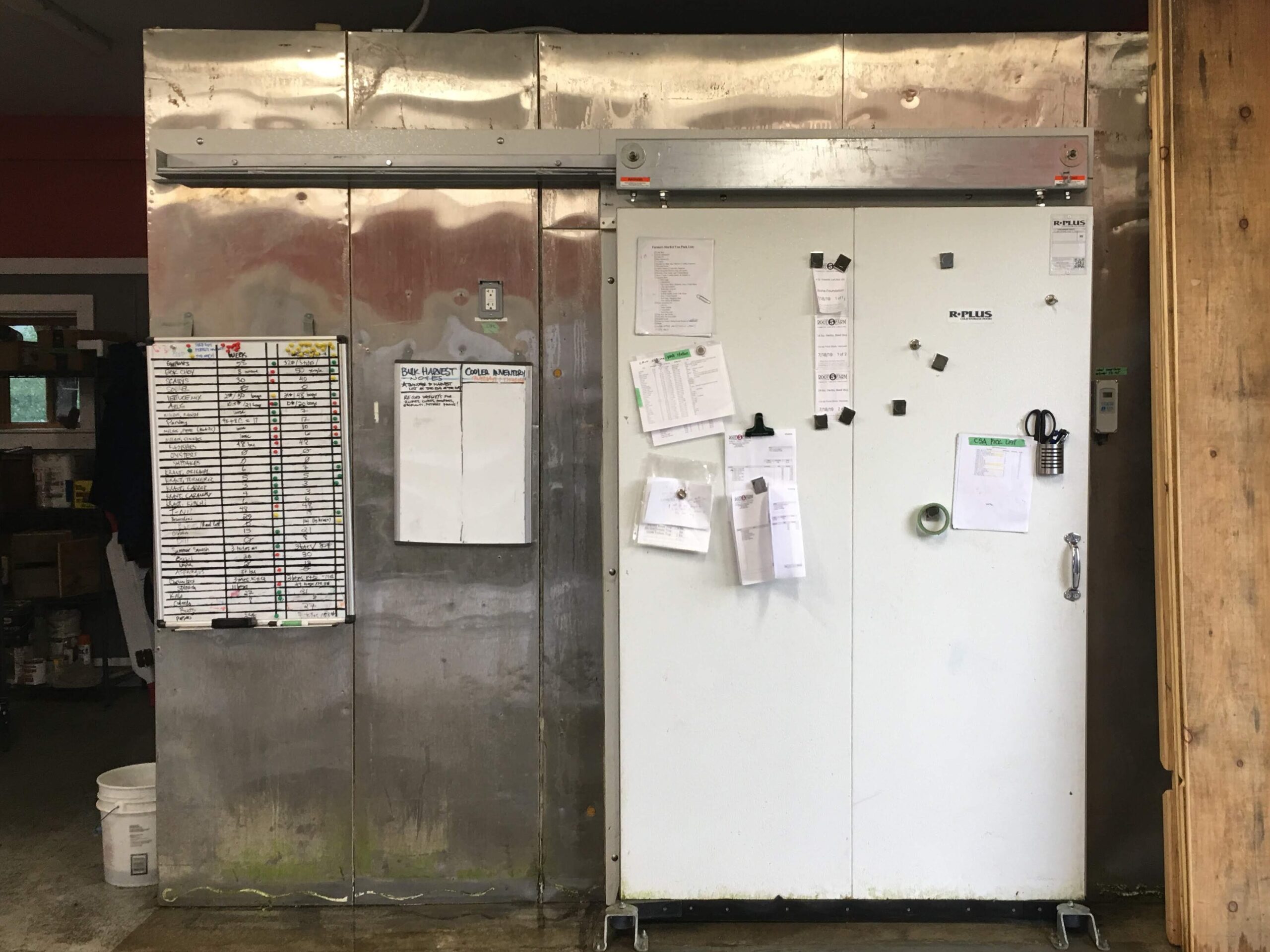
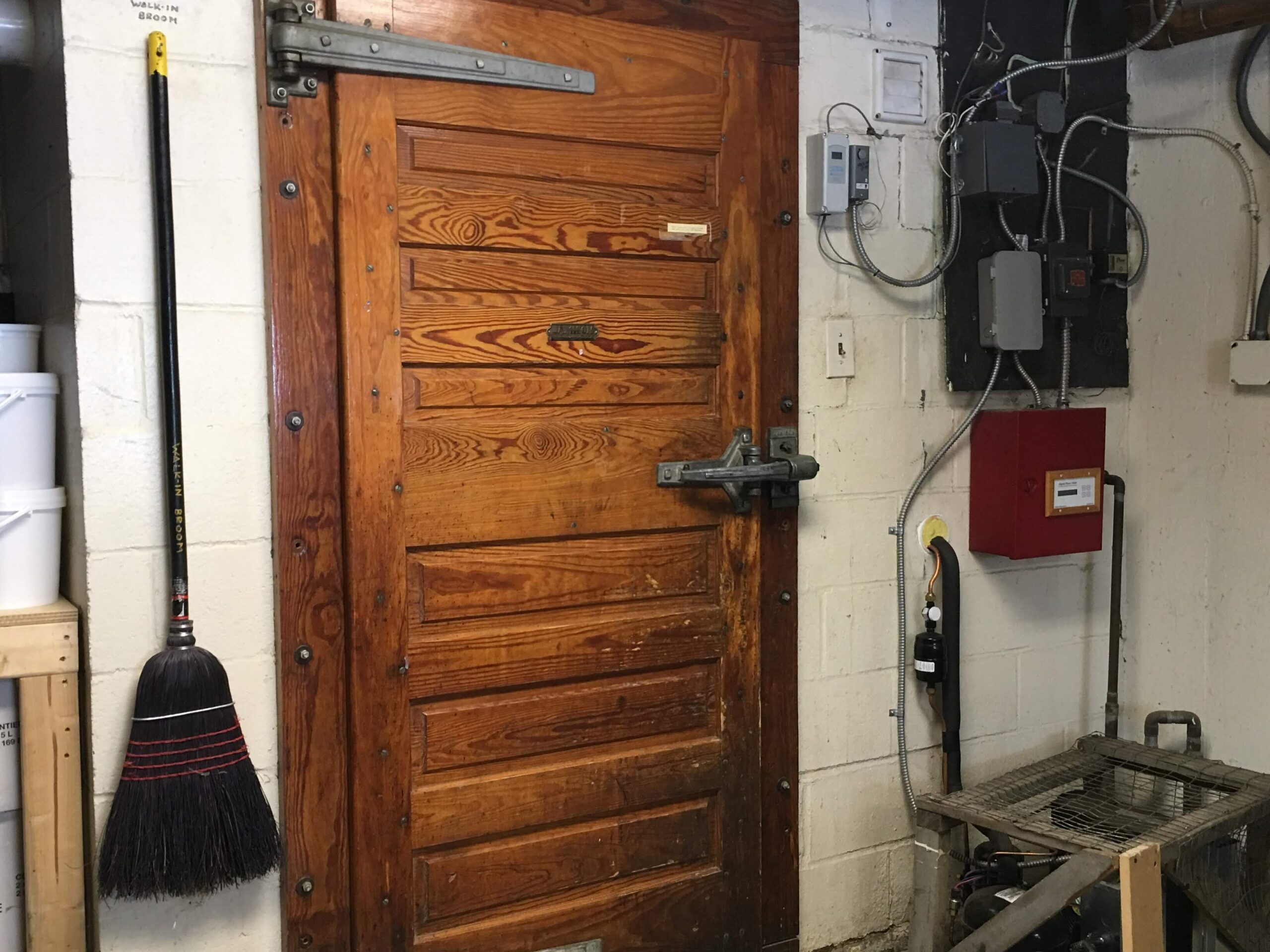
Farm Cooler Checklist
Cleaning and Sanitizing
- Empty storage room completely.
- Sweep / vacuum inside of storage room.
- Clean inside surfaces of storage room with an appropriate cleaner or detergent.
- Sanitize inside surfaces of storage room with an appropriate sanitizer.
- Dry thoroughly. Allow time, provide ventilation and consider heating slightly to ensure complete and thorough drying.
- Upgrade or Repair Finish Surfaces to ensure a solid, smooth, cleanable interior.
Envelope
- Inspect envelope for damage, cracks or other openings and seal as needed. (http://go.uvm.edu/coolerwalls).
- Check for daylight from the inside with the door closed and lights out. Repair seals as needed.
- Adjust door closers and latches for a secure seal when closed.
- Check for signs of rodents or other pests and make necessary changes to prevent them.
Equipment
- Inspect power wiring and outlets or junction boxes for wear or other items needing repair.
- Confirm or install working lights. Consider efficiency upgrades to lighting and using an occupancy switch. (http://go.uvm.edu/effvtag)
- Check insulation and ensure good general condition of refrigerant lines.
- Clean evaporator (inside) fins to be sure air can move freely through them. You should be able to see light through each channel.
- Clean evaporator drain pain and look for signs of blockage (e.g. standing water, sediment, mold, etc.)
- Ensure evaporator drain is functioning, directing drain water outside of room.
- Clear the compressor and condenser (outside) of leaves or other debris.
- Clean the condenser (radiator) fins with a vacuum and/or pressure washer.
- Protect the compressor and condenser from the elements with a shed roof, etc.
Operation of Cooling
- Confirm thermostat operation, set a low temperature on the thermostat and listen for the “click” of a relay or note the output indicator light. Consider whether a thermostat upgrade is appropriate.
- Check operation of evaporator fans (inside). Do they come on uniformly when the unit is powered up? Is the unit providing cold air? Evaporator fans are often a key efficiency upgrade that is likely supported by Efficiency Vermont (http://go.uvm.edu/effvtag).
- Check operation of compressor and condenser fan (outside). Is the compressor running when there is a call for cooling. Is the condenser fan running. Are refrigerant lines hot between the compressor/ condenser and cold going back to the evaporator inside? Time to consider an energy efficiency upgrade? (http://go.uvm.edu/effvtag).
CoolBots™
- Pitched down and out, allowing for evaporator water to drain away toward the outside.
- Ensure the drainage hole is open and clear allowing water to drain.
- Ensure both heat exchangers are clean (inside/evaporator and outside/condenser).
- Set the AC vent according to whether you want outside air makeup or not.
- Check location and condition of temperature sensors, especially the fin sensor.
- Check the seal around the AC unit in the wall to make sure it is sound and preventing air infiltration.
- Check operation of the unit by forcing a call for cooling (set a low temperature).
Lighting
- Replace bulbs or fixtures that are not working.
- Repair any broken coverings, corrosion.
- Clean as necessary to remove dirt and other debris.
Capacity and Planning
- Do you have all the storage space you need for the coming year? Time for a quick expansion or a new zone? (http://go.uvm.edu/cropplanner)
Share This Post!
Additional Cooler Resources
Cooler Construction Options – Walls and Panels
Acknowledgements
This resource was developed as part of the Food Safety Outreach Program under grant number 2020-70020-33003 from the USDA National Institute of Food and Agriculture and also funded, in part, by the USDA Northeast Sustainable Agriculture Research and Education program through award LNE19-375 and by the Food and Drug Administration through The Vermont Agency of Agriculture Food and Markets via the Integrated Extension Educational Programming in Support of the VAAFM Produce Program Grant 02200-FSMA-2018-01. The views expressed in the publication do not necessarily reflect the official policies of the U.S. Department of Agriculture, the U.S. Department of Health and Human Services or the Vermont Agency of Agriculture; nor does any mention of trade names, commercial practices, or organization imply endorsement by the United States Government or the State of Vermont. It is offered without regard to race, color, religion, sex, sexual orientation, gender identity, national origin, disability, protected veteran status, or any other category legally protected by federal or state law.
